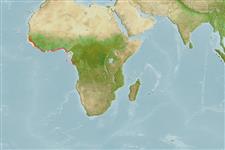Élasmobranches (requins et raies) (sharks and rays) >
Carcharhiniformes (Ground sharks) >
Sphyrnidae (Hammerhead, bonnethead, or scoophead sharks)
Etymology: Sphyrna: Probable misspelling of sphyra (Gr.), hammer, referring to their hammer-shaped heads (See ETYFish).
Eponymy: Monsieur Couard was Director of shark fisheries off the coast of Senegal, the type locality. Unfortunately we can find nothing more about him. (Ref. 128868), visit book page.
Environment: milieu / climate zone / depth range / distribution range
Écologie
marin benthopélagique. Tropical; 17°N - 5°S, 19°W - 13°E
Eastern Atlantic: Senegal to Congo. Not in Compagno's 1999 checklist (Ref. 35766).
Taille / Poids / Âge
Maturity: Lm ? range ? - ? cm
Max length : 300 cm TL mâle / non sexé; (Ref. 244)
A coastal-pelagic shark. Feeds on fishes, especially bony fishes, and also benthic and epibenthic cephalopods. Viviparous, with 24 to 28 young in a litter. Size at birth about 30 to 32 cm.
Life cycle and mating behavior
Maturité | Reproduction | Frai | Œufs | Fécondité | Larves
Viviparous, placental (Ref. 50449).
Compagno, L.J.V., 1984. FAO Species Catalogue. Vol. 4. Sharks of the world. An annotated and illustrated catalogue of shark species known to date. Part 2 - Carcharhiniformes. FAO Fish. Synop. 125(4/2):251-655. Rome: FAO. (Ref. 244)
Statut dans la liste rouge de l'IUCN (Ref. 130435: Version 2024-2)
Menace pour l'homme
Traumatogenic
Utilisations par l'homme
Pêcheries: pêcheries vivrières
Outils
Articles particuliers
Télécharger en XML
Sources Internet
Estimates based on models
Preferred temperature (Ref.
123201): 24.4 - 28, mean 26.7 °C (based on 64 cells).
Phylogenetic diversity index (Ref.
82804): PD
50 = 0.5029 [Uniqueness, from 0.5 = low to 2.0 = high].
Bayesian length-weight: a=0.00347 (0.00153 - 0.00788), b=3.12 (2.93 - 3.31), in cm total length, based on LWR estimates for this (Sub)family-body shape (Ref.
93245).
Niveau trophique (Ref.
69278): 4.5 ±0.54 se; based on food items.
Résilience (Ref.
120179): Faible, temps minimum de doublement de population : 4,5 à 14 années (Fec=24).
Fishing Vulnerability (Ref.
59153): Very high vulnerability (90 of 100).
